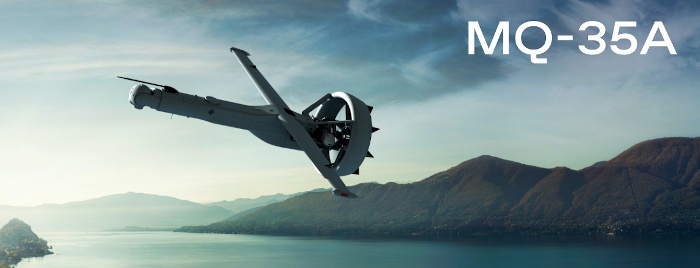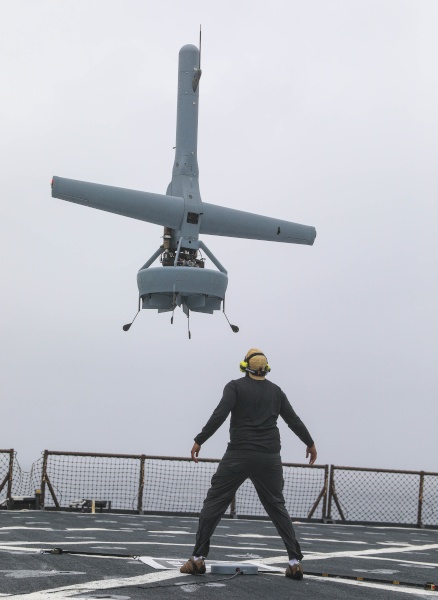Shield AI MQ-35 V-BAT
The development of the V-BAT VTOL UAV by a company named MLB began around 2008, and gained some pace in 2010/11 with the help of one DARPA and two USAF SBIR (Small Business Innovation Research) contracts. In 2015, MLB was acquired by MMLP (Martin Midstream Limited Partners) and renamed Martin UAV. The company developed the V-Bat through several iterations, and in 2021, the U.S. Navy selected it for further development for its VTOL UAS requirement after a downselect from 13 competitors. Later that year, Martin UAV was acquired by the startup Shield AI. In March 2023, the U.S. Army selected the V-BAT, offered by a team of Northrop Grumman and Shield AI, as one contender for its FTUAS (Future Tactical Unmanned Aircraft System), scheduled to replace the RQ-7B Shadow. In May 2023, Shield AI announced in various social media channels, that the V-BAT had received the official military designation MQ-35A.
 |
| Photo: Shield AI |
| MQ-35A |
The MQ-35A is a "tail sitter" VTOL aircraft, powered by a two-stroke piston engine driving a shrouded propeller. For launch and recovery, the vehicle needs only a 6 m × 6m (20 ft × 20 ft) area and two people on the ground. The primary missions of the UAV, as envisioned by the Navy, are ISR and ship-board light cargo delivery. Standard equipment consists of EO (Electro-Optical) and IR cameras.
 |
| Photo: MC 3rd Class Moises Sandoval, U.S. Navy |
| MQ-35A |
A core feature of the MQ-35A is "Hivemind", an AI-based control software developed by Shield AI. This enables the drone to operate autonomously in environments without communications or GPS. It also gives the V-BAT "swarming" capabilities, where several UAVs can "work together" to achieve their objectives. With the current software, up to four V-BAT UAVs can team up, but Shield AI plans to increase this number significantly.
Designation Note: The wording and context of Shield AI's "MQ-35A" announcement make it pretty clear, that this is indeed an official MDS. At the time of this writing, no design numbers in the Q-series between RQ-28A and MQ-35A have been announced, and 6 newly assigned but still unpublished numbers (29 through 34) within less than 2 years would be rather unusual. So it's easily possible that the number 35 was assigned out of sequence, for whatever reason.
Specifications
Note: Data given by several sources show slight variations. Figures given below may therefore be inaccurate!
Data for MQ-35A:
| Length | 2.74 m (9.0 ft) |
| Wingspan | 2.96 m (9.7 ft) |
| Weight | 56.7 kg (125 lb) |
| Speed | 90 km/h (56 mph) |
| Ceiling | 6100 m (20000 ft) |
| Endurance | 10 h |
| Propulsion | 1 Suter TOA 288 two-cylinder engine; 17.6 kW (24 hp) |
Main Sources
[1] Wikipedia: V-BAT
[2] MLB V-Bat
VTOL Unmanned Aerial Vehicle (UAV)
[3] Unmanned Systems Technology 015, Rory Jackson: Lift-off at last
[4] Shield AI website
[5] New Atlas: US Army
chooses V-BAT VTOL drone as potential RQ-7B Shadow replacement
[6] Defense News, Stephen Losey:
Shield AI unveils V-Bat Teams drone swarm tech, with eye to Replicator
[7] Military Factory: Shield AI V-BAT
Back to Directory of U.S. Military Rockets and Missiles, Appendix 2
Last Updated: 15 January 2024